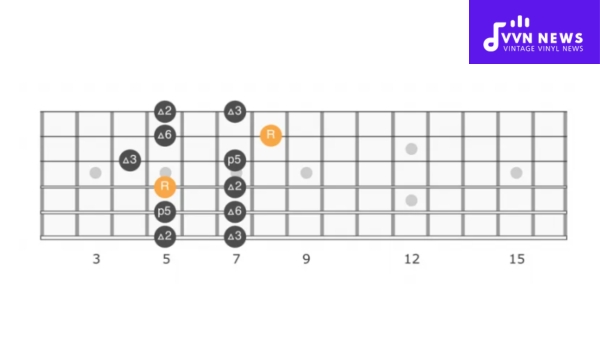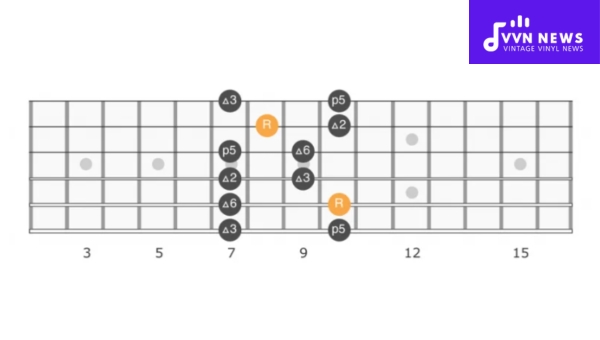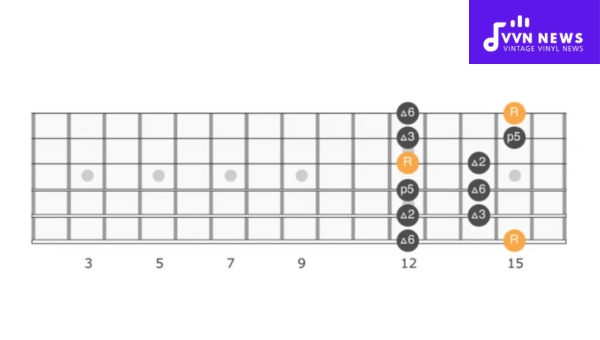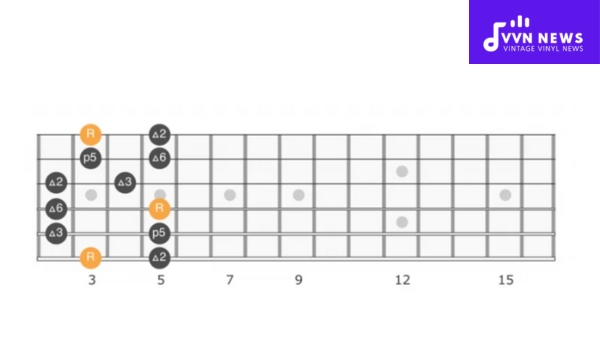Music can be a fresh oasis for a weary spirit, a canvas for unleashed creativity, or a labyrinth of harmonic complexities.
The beauty in music lies not just in the form of the notes but also in their seamless blend and timely harmony.
The G major pentatonic scale plays an integral component within this beautiful symphony of sound.
Navigating the G major pentatonic scale opens up an infinite array of melody possibilities.
It serves as a stepping stone towards creating enchanting compositions, adding depth to musical pieces, or even improvising on the spot with your instrument.
If you’re saying hello to music for the first time or if you’re attempting to brush up on your theoretical grounding, this guide will help unravel the mystery of this endearing musical scale.
What is the G Major Pentatonic Scale?
The G Major Pentatonic Scale consists of five notes: G, A, B, D, and E. It’s a variant of the major scale that skips the fourth and seventh notes (C and F# in the standard G Major scale), giving it a distinctively smooth and uncluttered sound.
Not only is it prevalent in various music genres – from blues to country to rock – but its relative simplicity makes it a favorite among guitarists and melodic instrumentalists alike.
This scale is perfect for crafting solos that carve clear melodic lines through harmonic complexity, all while remaining anchored in the comforting embrace of G major tonality.
How do you create the G Major Pentatonic Scale?
Creating the G Major Pentatonic Scale is akin to uncovering a precise pattern within a larger musical framework.

The scale is comprised of five notes, selected from the natural G Major Scale – an octave span that traditionally houses seven notes.
Here’s the process to carve out the pentatonic from its parent scale:
- Start with the G Major Scale: G, A, B, C, D, E, and F#.
- Select Key Notes: To form the pentatonic version, use the first, second, third, fifth, and sixth notes of this family: G (root), A (second), B (third), D (fifth), and E (sixth).
- Omit Specific Tones: Remove the fourth and seventh degrees – C and F# are excluded to achieve that distinctive pentatonic sound.
- Arrange Sequentially: Align your selected notes in ascending or descending order without any gaps.
Also Read: F Major Pentatonic Scale [In-Depth Music Guide For Beginners]
The outcome:
- G (root)
- A (major second)
- B (major third)
- D (perfect fifth)
- E (major sixth)
Upon mastery of these steps using various instruments or even your voice, you unlock an array of melodies bound by these five tones.
The quintessence of simplicity and sonic beauty is what makes the G Major Pentatonic Scale a cornerstone in countless genres across countless melodies.
What are the five outlines of the G Major Pentatonic Scale?
Embarking on the journey of learning guitar scales is akin to acquiring a new language; it opens up a world of expressive possibilities.
The G major pentatonic, particularly beloved for its melodic potential, is comprised of five distinct patterns or shapes, each one functionally a piece of a larger musical puzzle.
Here I’ll unveil these essential forms that are key to this versatile scale.
Shape 1: The Open Position
The first pattern often serves as an initial introduction due to its ergonomic placement around open strings.
Embrace the freedom and accessibility as your fingers grapple with notes G, A, B, D, and E dispersed across your fretboard from the open string to the third fret.
This shape’s foundation hovers around the classical open position coverage area and is crucial for setting the pace for understanding subsequent patterns.
Shape 2: The Stretch Position
As we progress up the neck, shape two places itself predominantly between frets two and five. It requires a bit more dexterity.
The pattern begins on your low E string with your second finger positioned on G at the third fret.
Let each note ring clearly as you ascend through this configuration where stretching between intervals becomes imperative.
Shape 3: The D Form
Climbing further up the neck brings us to our third outline featuring an arrangement encased within frets five through eight; it receives its name due to its resemblance to an open D chord if transposed along the guitar neck.
This ‘D form’ advances musical agility by utilizing slides and shifts in hand position—essential techniques while exploring scale variations.
Shape 4: One Octave Upward
Situated between frets seven through ten, our fourth frame offers an octave leap from where we opened our expedition.
Familiarize yourself with this zone as all notes resound at higher pitches offering you insights into transitioning seamlessly between registers during solos or improvisations.
Shape 5: Closing Octave
Addressing shape five which envelops frets ten to twelve—it mirrors our initial open position yet operates an octave higher adding coloration by exploiting tonal gravity at loftier freight regions.
Adeptly traversing these positions endows your arsenal with nimble adaptability.
With diligent practice melding G major pentatonic scales, watch as they concatenate fluidly across your guitar’s expanse empowering you with command over melodic landscapes and enriching your musical expression exponentially.
Also Read: E Flat Major Pentatonic Scale [Play Warm And Harmonic Tunes]
How do Relative Major and Minor Pentatonic Scales Interact?
In the realm of music theory, relative major and minor scales are two sides of the same coin.

They share the same notes but start on different roots, which creates unique tonalities.
For instance, if you take the G major pentatonic scale—comprising G, A, B, D, and E—and begin on its relative minor root E, you’ve stumbled upon the E minor pentatonic scale.
The inherent connection allows musicians to fluidly transition between emotions in a piece; bright optimism in G major can segue into a more introspective mood in E minor.
To illustrate this relationship through scale degrees:
- G Major Pentatonic: G (1) – A (2) – B (3) – D (5) – E (6)
- E Minor Pentatonic: E (1) – G (♭3) – A (4) – B (5) – D (♭7)
By tapping into these interlinked scales, one can confidently weave through melodies that are complex yet cohesive.
Exploring their dual nature enriches improvisation skills, as you’ll have a versatile palette from which to draw your musical expressions.
How useful are backing tracks for the G Major Pentatonic Scale practice?
Practicing scales might sometimes feel monotonous, but incorporating backing tracks can transform your practice into an engaging musical experience.
When it comes to the G Major Pentatonic Scale, backing tracks serve as an invaluable tool for several reasons:
Developing Musical Ear
The use of backing tracks exposes you to the diverse contexts in which the G Major Pentatonic scale can be applied.
By playing along, you attune your ear to the subtleties of how each note resonates against different chord progressions and rhythms.
This auditory training evolves your ability to anticipate harmonic structures and improvise with confidence.
Rhythm and Timing Enhancement
When accompanied by a backing track, you’re not just hitting notes; you’re syncing with an established pace, compelling you to maintain a consistent rhythm.
Your sense of timing improves as you align your playing with the beat, which is vital for performing with other musicians or recording sessions.
Instructional Alternatives
- Interactive Listening: With varied instrumental layers present in a track, you gain insights into integrating the pentatonic scale within a full-band setting. It’s akin to a practical workshop where melodic improvisation occurs naturally.
- Dynamic Response: Backing tracks often include changes in dynamics and tempo that prompt adaptive playstyle adjustments.
Reacting to these shifts during practice develops your musical responsiveness.
Creative Exploration
Backed by different progressions and styles—be it rock grooves or laid-back blues—the pentatonic notes yield distinct flavors.
Your creative horizons expand as melodic patterns emerge, revealing nuance in simplicity.
Motivation Boost
A lively backdrop infuses fun into practice sessions—this engagement leads to longer, more frequent practices without drudgery.
Increased motivation translates into consistent progress and enhanced proficiency on your instrument.
As an effective supplementary resource for knowing the G Major Pentatonic Scale, consider exploring a diverse selection of backing tracks.
Tailoring these tools within your routine culminates in a rounded musicianship — braced by both theoretical and practical applications.
Also Read: D Major Pentatonic Scale [Learn Its Uplifting Melodies]
Which Popular Songs Have the G Major Pentatonic Scale?
The pentatonic scale is a musician’s playground, brimming with melodic simplicity and versatile expression.

The G major pentatonic scale, in particular, has been the hidden hero in various iconic tunes. Here are five songs that showcase the beauty and ubiquity of this scale:
“My Girl” by The Temptations
A quintessential example where the G major pentatonic imparts soul and grace is “My Girl.”
This classic hit utilizes pentatonic runs that form its enchanting melody.
Those memorable guitar lines glide effortlessly across sections of the G major pentatonic, creating a soothing background that complements the vocal harmonies.
“Sweet Home Alabama” by Lynyrd Skynyrd
The Southern Rock anthem “Sweet Home Alabama” beautifully incorporates riffs from the G major pentatonic scale.
The signature three-chord progression is complemented by guitar solos that sail through the scale’s notes, epitomizing a sound that is both gritty and melodic—a tribute to this versatile scale.
“Brown Eyed Girl” by Van Morrison
Another song where you can easily identify sequences from the G major pentatonic is Van Morrison’s feel-good track “Brown Eyed Girl.”
The lighthearted guitar intro and solos weave through this scale, offering a bright tonal quality to this undying pop standard.
“Cinnamon Girl” by Neil Young
Neil Young’s raw edge in “Cinnamon Girl” includes rifts extracted directly from the G major pentatonic scale.
Here it gives forth its characteristic warmth, allowing for catchy hooks that are easy for anyone to hum along to—who knew such complexity could live within simpleness?
“Black Magic Woman” by Santana
Carlos Santana’s instrumental work often circles various pentatonics; his piece “Black Magic Woman” has instances where it draws from our celebrated G major pentatonic.
The lead guitar dips into soulful phrases that are sculpted out of this magical sequence of notes.
It’s remarkable how these diverse songs weave in elements of one straightforward five-note set—each with its unique twist but linked together through their use of the G major pentatonic scaffold.
Also Read: G Sharp Minor Scale [Explore Its Melancholic Musical Potential]
FAQs About The G Major Pentatonic Scale
What is the G Major Pentatonic Scale?
The G Major Pentatonic Scale is a five-note musical scale with the notes G, A, B, D, and E.
How do I play the G Major Pentatonic on a guitar?
To play this scale on a guitar, begin with the open G string (third string) and follow through A (second fret), B (open second string), D (third fret), and E (open first string).
Can I use the G Major Pentatonic Scale for improvisation?
The G Major Pentatonic is ideal for improvisation due to its pleasant sound and versatility.
In which genres is the G Major Pentatonic Scale commonly used?
This scale often appears in blues, country, folk, rock, and even pop music genres.
Are pentatonic scales good for beginners to learn?
Yes! Pentatonic scales are beginner-friendly, offering an easier pathway to start soloing and learning musical patterns.
Conclusion
The G major pentatonic scale is an exciting journey into the world of music.
It’s a versatile tool that can inject melody and soul into your playing.
Whether you’re strumming a guitar or tickling the ivories, remembering these five simple notes—G, A, B, D, and E—will serve as your melodic compass.
Leverage this scale against a variety of backing tracks, and soon you’ll find yourself improvising with confidence.
Keep practicing, stay patient, and you’ll discover the joy of creating music that resonates with your style.








